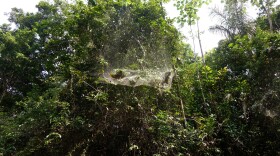-
-
Tyrell’s tufted, along with most jumping spider species, is not aggressive. Jumping spiders actively hunt their food using their speed, the hunters of the arachnid world.
-
While some silk slingers make large, elaborate webs, there’s one species that might at first appear a bit lazy in the web-building department. But what it seemingly lacks in motivation is more than made up for with style.
-
To an arachnophobe, nothing is more terrifying than the thought of a spider. Despite efforts to convince them how amazing spiders are, more than a few times our conversation ended with something like, “Well, thank goodness they can’t fly.” I’m sorry to say, that’s not exactly true.
-
When you’re a small frog in the jungle, you best be on the lookout as you’re on the menu of a variety of other animals. At about a half inch in length, frogs in the family microhylid – known as narrow-mouthed frogs – certainly fall into that category. But thanks to the unusual relationship some of these frogs in Peru, India and Sri Lanka have developed with different species of rather large tarantulas, they have a unique defense …an eight-legged bodyguard.
-
I love paddling my kayak, to get away even for just an hour or two. Sitting in my kayak one morning on a detention pond close to home, I watched a small, tan spider hopping on my paddle. I quickly took a picture, hoping to identify it later. Before I could enjoy watching this new-to-me spider too much, however, another spider—large, black, and hairy—emerged from under my paddle, ran up to the smaller spider, bit it, and started dragging it off!
-
Found in the Amazon rainforest of Peru, the slingshot spider has one of the most unique ways of using its web to capture prey.
-
Called the “Snail Shell Spider”, this species of huntsman spider has devised a unique strategy to secure a room with a view.
-
There are 3 species of black widows found throughout the United States — the southern, western, and northern black widows. Their appearance will vary depending on species, if it’s a male or female spider, and whether it’s an adult or juvenile.
-
These massive spiders are from the upland rainforest regions of northern South America and have the largest body size and mass of any spider. But despite their intimidating size and enormous fangs, biting is their last resort.
Play Live Radio
Next Up:
0:00
0:00
Available On Air Stations










